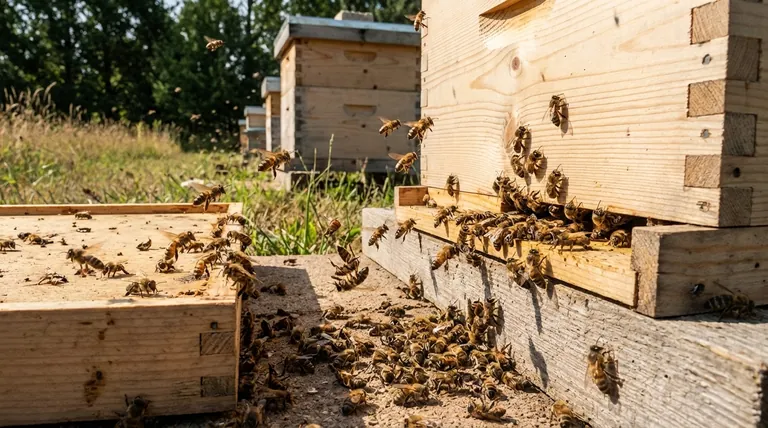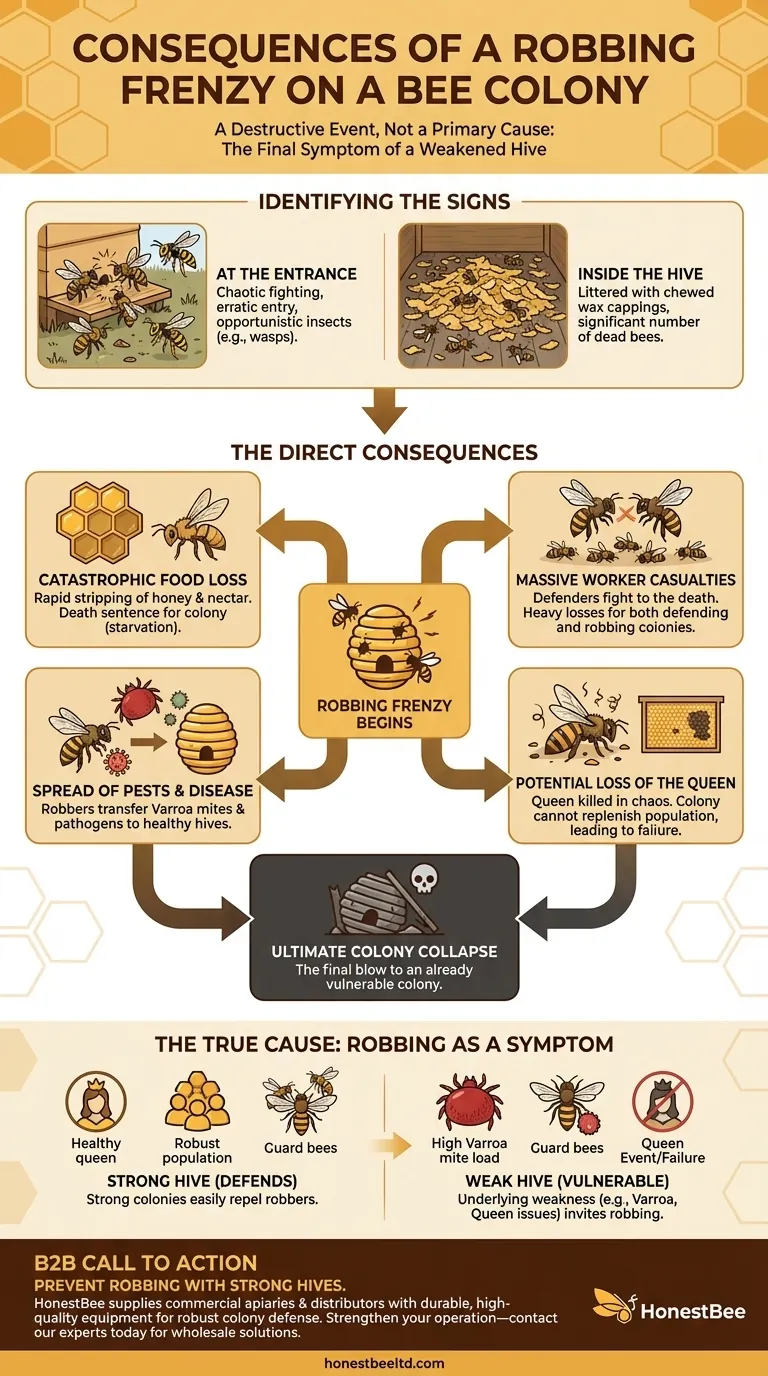Ultimately, a robbing frenzy is a destructive event that results in the large-scale loss of a colony's food stores, a significant number of dead bees, and the potential collapse of an already weakened hive. The chaos and fighting at the hive entrance are merely the external signs of a colony being stripped of its resources.
Robbing is best understood not as the primary cause of a colony's death, but as the final, violent symptom of a pre-existing weakness. A strong, healthy colony can almost always defend itself; a robbing event signals that the colony was already in deep trouble.

Identifying a Robbing Frenzy
Before understanding the consequences, you must be able to accurately identify the event. Unlike normal foraging, a robbing frenzy is chaotic and aggressive.
Signs at the Hive Entrance
You will see a frantic swarm of bees, often fighting and tumbling on the landing board and on the ground. The activity is erratic, with robbers trying to find any crack or gap to enter, rather than using the main entrance in an orderly fashion.
You may also see other opportunistic insects, like yellowjacket wasps, joining the attack.
Evidence Inside the Hive
After a robbing event, the signs are unmistakable. The bottom board will be littered with a large amount of chewed wax cappings, which look like small, shredded flakes.
This debris is left by robbers who have uncapped the honey cells to steal the contents. You will also likely find a significant number of dead bees inside the hive.
The Direct Consequences for the Colony
The immediate impact of robbing is severe and multi-faceted, going far beyond the simple loss of honey.
Catastrophic Loss of Food Stores
Robbing bees will strip a weak colony of its honey and nectar with extreme efficiency. This loss of stored food is a death sentence for a colony, especially heading into winter.
Massive Worker Bee Casualties
The defending bees will fight to the death to protect their resources. This results in heavy casualties for the defending colony and even significant losses for the robbing colony, weakening both.
Spread of Pests and Disease
Robbing is one of the most effective ways to spread pests and diseases throughout an apiary. Robbers carry back mites, such as Varroa destructor, and pathogens from the collapsing hive to their own healthy one, creating a new vector of infection.
Potential Loss of the Queen
In the chaos of a full-scale robbing frenzy, the defending colony's queen can be killed. The loss of a queen, especially during a period of high stress, means the colony has no way to replenish its population and will quickly fail.
The True Cause: Robbing as a Symptom
It is critical to understand that a robbing frenzy is rarely an isolated event. It is the end result of a colony that was already failing for other, more fundamental reasons.
The Role of Pre-existing Weakness
A strong, populous colony has enough guard bees to easily repel scout robbers before a frenzy can begin. Robbing succeeds because the target colony is too weak to mount an effective defense.
Common Underlying Stressors
The weakness that invites robbing is typically caused by other factors. A high Varroa mite load or a sudden queen event (such as the queen dying or failing) are the most common culprits that decimate a colony's population, making it an easy target.
How to Interpret a Robbing Event
Viewing a robbing frenzy through the correct lens is key to managing a healthy apiary. It is a critical, if unfortunate, diagnostic tool.
- If you see a hive being robbed: Your immediate focus should be on determining the underlying cause of its weakness, as the robbing itself is just the final stage.
- If you discover your own bees are robbing a weak hive: Recognize that while they are gaining resources, they are also potentially bringing devastating pests and diseases back to their own colony.
A robbing frenzy serves as a harsh indicator of a colony's failure to thrive, demanding a deeper look into the overall health of your apiary.
Summary Table:
| Consequence | Impact on the Colony |
|---|---|
| Loss of Food Stores | Colony is stripped of honey and nectar, leading to starvation. |
| Massive Bee Casualties | Heavy losses for both defending and robbing colonies. |
| Spread of Pests & Disease | Varroa mites and pathogens are carried back to healthy hives. |
| Potential Queen Loss | Chaos can lead to the queen's death, preventing population recovery. |
| Ultimate Colony Collapse | The event is often the final symptom of a pre-existing weakness. |
Is your apiary prepared to prevent a robbing frenzy? A robbing event is a clear sign of underlying hive weakness. Protect your investment and ensure your colonies are strong, healthy, and well-equipped. HONESTBEE supplies commercial apiaries and beekeeping equipment distributors with the durable, high-quality supplies needed to maintain robust hives and effective defenses. Let's strengthen your operation—contact our experts today for wholesale solutions.
Visual Guide

Related Products
- Wholesales Dadant Size Wooden Bee Hives for Beekeeping
- Professional Multi-Function Stainless Steel Hive Tool
- Professional Insulated Plastic Bee Hives
- Honey Flow Garden Bee Hive Flow Hive Best Beehive for Beginners
- Professional Large-Format Hive Number Set for Beekeeping
People Also Ask
- What is beekeeping equipment? Essential Tools for Commercial Apiaries & Distributors
- What is the best place to keep bees? Find the Perfect Apiary Site for Your Hives
- What are the advantages of wooden bee hives? Superior Bee Health & Beekeeper Flexibility
- What types of products are available for beekeeping needs? Essential Equipment for Apiaries & Distributors
- What are the characteristics of oil-based paint for beehives? Durability vs. Modern Practicality



















